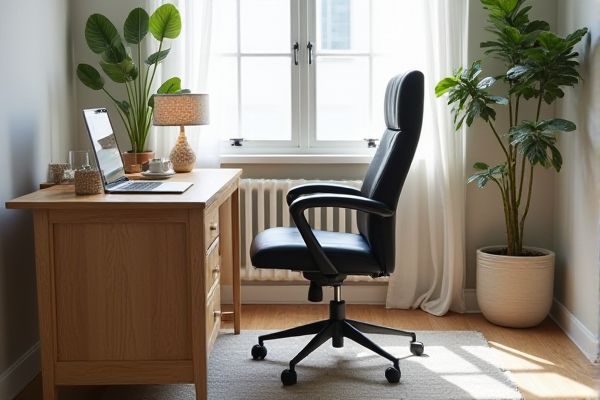
A desk chair typically offers basic comfort and support suited for short periods of sitting, while a task chair is designed with ergonomic features to support prolonged use and promote better posture. Discover how choosing the right chair can enhance Your workspace comfort and productivity by reading the rest of the article.
Table of Comparison
| Feature | Desk Chair | Task Chair |
|---|---|---|
| Primary Use | General office use, casual sitting | Focused work, extended computer tasks |
| Ergonomics | Basic ergonomic support | Advanced ergonomics with lumbar support |
| Adjustability | Limited adjustments (height, swivel) | Multiple adjustments (height, tilt, armrests) |
| Mobility | Usually stationary or on gliders | Casters for easy movement |
| Design | Simple, traditional style | Modern, functional design |
| Price Range | Lower to mid-range | Mid to high-range |
| Common Materials | Fabric or basic mesh | High-quality mesh, leather options |
Introduction: Understanding Desk Chairs and Task Chairs
Desk chairs typically feature adjustable height and swivel capabilities designed for general office use, offering comfort during extended periods of sitting. Task chairs prioritize ergonomic support with adjustable lumbar support, armrests, and seat depth to enhance productivity in focused work environments. Both types aim to improve posture and reduce strain but cater to different user needs and workspace setups.
Key Differences Between Desk Chairs and Task Chairs
Desk chairs typically feature a larger, more cushioned design with adjustable height and armrests for prolonged comfort during office work, while task chairs are more compact, lightweight, and designed for quick mobility in dynamic workspaces. Task chairs often include swivel capabilities and breathable materials, optimizing productivity for short to moderate durations. Your choice depends on ergonomic needs, space availability, and the nature of your daily work activities.
Design and Ergonomics Comparison
Desk chairs offer a classic design with padded seats and may lack advanced ergonomic features, while task chairs emphasize adjustable components such as lumbar support, seat height, and armrests designed to promote better posture during extended use. Ergonomically, task chairs often incorporate breathable mesh backs and dynamic seating mechanisms to reduce fatigue and enhance comfort, which is less common in standard desk chairs. Choosing between the two depends on the balance of aesthetic preference and the need for customizable ergonomic support in a workspace.
Comfort and Support Features
Desk chairs typically offer basic comfort with limited adjustable features, making them suitable for short periods of use, whereas task chairs are designed with ergonomic support in mind, featuring adjustable lumbar support, seat height, and armrests to enhance comfort during extended work sessions. Task chairs promote better posture with contoured backrests and breathable materials, which reduce fatigue and discomfort over time. Choosing the right chair influences your overall comfort and productivity by providing tailored support that adapts to your body's needs.
Adjustability and Customization Options
Task chairs offer superior adjustability and customization options compared to standard desk chairs, featuring adjustable seat height, lumbar support, and armrests tailored to your ergonomic needs. Many task chairs include tilt tension control and seat depth adjustments to promote better posture and reduce strain during prolonged use. Investing in a task chair enhances your comfort and productivity by allowing precise modifications to fit your unique body and work style.
Materials and Build Quality
Desk chairs often feature durable materials like leather or high-grade mesh paired with robust metal or reinforced plastic frames, providing long-lasting support and comfort. Task chairs prioritize ergonomic design with breathable fabrics and adjustable components that enhance mobility and reduce strain during extended use. Your choice between these chairs should consider the balance of build quality and material suited to your daily work demands.
Best Uses for Desk Chairs
Desk chairs are best suited for extended computer work and office tasks due to their ergonomic design, adjustable height, and lumbar support features that promote comfort and posture during long hours. These chairs typically offer swivel capabilities and padded armrests, which enhance ease of movement and reduce strain while performing detailed tasks. If your work involves prolonged sitting in front of a desk, choosing a desk chair tailored for focused productivity will support Your efficiency and well-being.
Best Uses for Task Chairs
Task chairs are designed for extended periods of desk work, offering ergonomic support with adjustable features like lumbar support, seat height, and swivel capabilities to enhance productivity and comfort. They are best suited for office environments, home workstations, or any setting requiring prolonged focus and movement. Unlike desk chairs, task chairs prioritize functionality and mobility, making them ideal for tasks that demand frequent shifts in posture and dynamic interaction.
Price Range and Value for Money
Desk chairs typically range from $50 to $300, offering basic comfort and style suitable for home use, while task chairs, priced between $150 and $600, provide enhanced ergonomic features and adjustability designed for prolonged office work. Investing in a task chair often delivers better value for money through improved support, durability, and productivity benefits, making it ideal for users seeking long-term comfort. Desk chairs may suit occasional use or budget constraints but lack the specialized features that justify the higher cost of task chairs.
Choosing the Right Chair for Your Workspace
Selecting the ideal chair for your workspace hinges on comfort, ergonomics, and functionality; desk chairs typically offer bulkier designs with more padding, suitable for prolonged sitting and executive tasks. Task chairs prioritize mobility and adjustability, featuring lighter frames, swivel bases, and height adjustments to support dynamic work environments. Evaluating your daily activities, space constraints, and ergonomic needs ensures you choose a chair that maximizes productivity and reduces strain during work hours.
 homyna.com
homyna.com